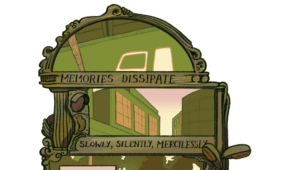
Change is a constant; but is it constantly better? And if it is: better for whom?
On June 17, 2024, the School of the Art Institute of Chicago’s on-campus catering service changed hands from Food for Thought to HandCut Foods. This was the result of a “months-long search process,” in an attempt to reassess the campus’ dining experience, according to SAIC’s official website. But how does the SAIC Community feel about this change? Does HandCut Foods uphold its claim of providing a dining service that is “simple, safe and delicious”?
F Newsmagazine conducted an online survey as well as in-person interviews with students to learn about first-hand experiences with HandCut Foods. Common themes included higher prices for lower quality food; limited vegetarian, vegan and/or gluten-free options; the mixing up of hot and iced beverage orders; and the blandness and dryness of the grab-and-go food options.
Order customization is one of the biggest challenges HandCut is facing, including allergy alternatives. There are gaps between the use of the kiosk and placing manual orders.
“Students place their orders on the kiosk and come to us with their receipts. However, for some reason, the kiosk receipts don’t get scanned, and we end up having to input the order manually anyway,” said Mellissa Coleman, the HandCut staff supervisor at the Sharp Building.
Coleman said this also is the reason why the queues, specifically during lunchtime, seem endlessly long.
The kiosk system is new for the SAIC cafeterias. They were added when HandCut took over from Food for Thought.
“One-to-one substitutions may not be available for every ingredient of every menu item. However, we’ve strived to create a balanced menu where every student can have the experience that they are looking for,” said Aaron Jacobson, vice president of operations at HandCut Foods.
Aside from the customization issues, customers also are experiencing issues with orders being mixed up.
“I get my hot coffee iced, five out of 10 times. Today, I just left the iced coffee on the counter, didn’t attempt to correct the order and let go of the amount I’d paid for it, because I had to head back to class,” said SAIC student Aishwarya Shivkumar (MArch 2026).
“When mistakes happen, we identify the source of the problem, and that informs our response. Some mistakes can be fixed by additional training. Some mistakes are systemic and require systemic solutions, like a change in operations tools or labeling standards,” said Jacobson.
For people with dietary restrictions, compromised immune systems, and disabilities, eating can be stressful and complicated. People with visual impairments said the text on the menu boards was illegible. The color contrast of the fonts and their image backdrops in the kiosks are hard to read, even after taking pictures of options on the phone and enlarging them.
HandCut Foods has an app where students can order food in advance and pick it up later. But users have complained that the interface of that, too, is inaccessible. According to Jacobson, the technology platform the app runs on is owned by SAIC.
So, given these challenges, what does an inclusive and accessible college cafeteria look like?
Martin Perales, academic support coordinator at the Disability Learning Resource Center believes that an accessible college cafeteria is one where all students can dine comfortably, regardless of ability.
A space of this nature should “consider a design that allows all students to navigate the space, have various food options that consider dietary restrictions, and be marked appropriately,” said Perales.
In terms of infrastructure, this would include wide aisles, adjustable counters, and clear signage with Braille and large print.
“Staff should be trained to help students with dietary needs, and there should be quiet zones for those with sensory sensitivities,” said Perales.
Building inclusive infrastructure comes at a cost. Perales stressed that there are challenges, space limitations, and budget constraints that can pose hurdles when it comes to trying to ensure they meet the needs of students.
“There is a broad spectrum of abilities that the institution must keep in mind: physical, sensory, and dietary,” Perales said.
An additional issue HandCut faces is that it is considerably understaffed on certain days, with one staff member sometimes attending to three separate stations.
“Business volume is a consideration in staffing decisions,” Jacobson said.
More staff would likely make a difference in overall dining experience. The resounding consensus amongst the SAIC community is that the HandCut Foods staff are kind, hospitable, and immensely helpful.
Debbie Martin, interim dean and vice president of student affairs at SAIC, said the school has convened a student committee to help identify issues, and that it has explicitly asked HandCut to address concerns around quality of food, pricing, accessibility, food labeling, and staffing.
“I have personally been meeting with the president of HandCut on a weekly basis to resolve these issues, and will continue to do so until HandCut meets our standards. While we have seen some improvements to the grab-and-go and hot food options over the last couple of weeks, we expect to see significant improvement, or we will need to reassess if they are able to remain our dining services partner,” said Martin.
HandCut Foods is particularly effective at paying heed to and incorporating student feedback. It has affected changes such as reintroducing sushi as part of the breakfast menu.
In response to the aforementioned online survey, Kyle Price (MFA Performance 2025) had a suggestion to make: “Allowing for more self-service buffets, rather than made-to-order options.”
In each of the three cafeterias, there is a small whiteboard placed right next to the register or up on the wall with the words, “We want to hear from you.” All you need to do is scan the QR Code and send in your feedback with the assurance of anonymity.







